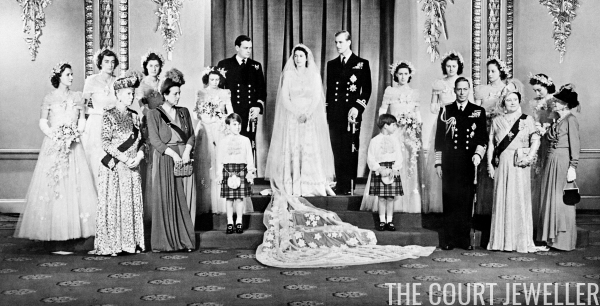 |
| Philip and Elizabeth with their wedding party and their families, 20 November 1947 (AFP/Getty Images) |
LONDON, November 20 — The cream and gold, crimson-cushioned chairs of the sanctuary were empty, the carpet untrodden, and, all unobscured, the gold plate mass on the snowy cloth of the High Altar gathered the warm flickers of the chandeliers, heightened them, and sent a ray of dazzling light from end to end of the Abbey. The arriving guests, shown to their places by the gentlemen ushers and gold staff officers, made no more than the faintest rustling as they moved.
The Abbey waited and, like a shell which confides most gently the roaring sound of the sea, trembled and stilled, stilled and trembled to the rising and falling waves of applause from that invisible multitude in which these ancient walls were islanded.
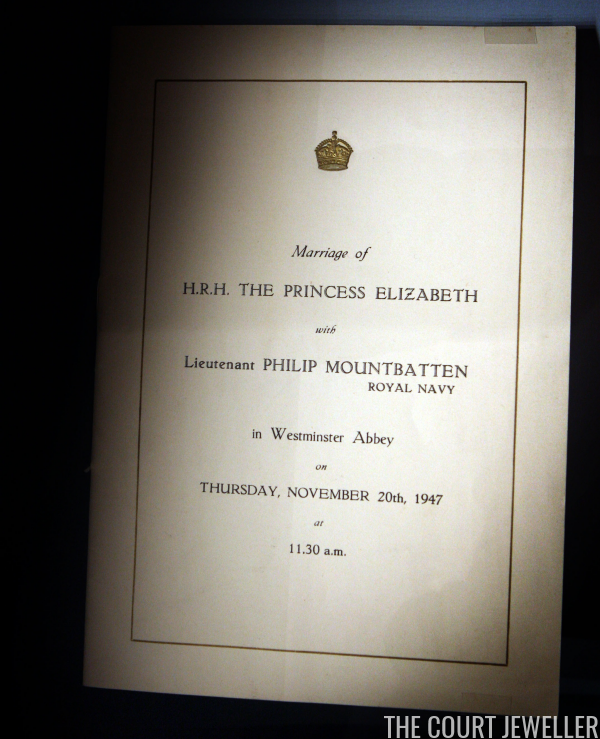 |
| Elizabeth and Philip’s wedding program (Peter Macdiarmid/Getty Images) |
Expectant, the growing congregation waited, its expectancy shown more pointedly than that of the greater congregation in Parliament Square and Whitehall, by its still, silent rigidity. It was a congregation sombre in appearance if not in spirit, for most of the men were wearing morning dress, and the women furs and hats that were not at all vivid. Quietly they took their places and very cautiously they turned the pages of the Marriage Service; and over the heads of all of them the altar glowed and twinkled like a golden beacon.
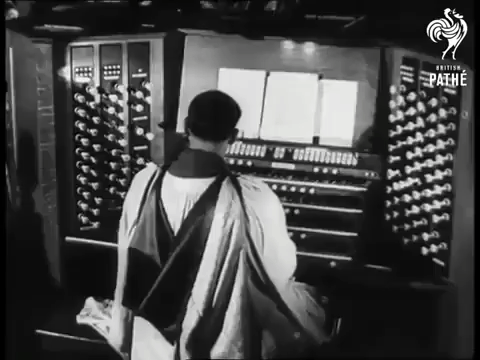 |
| The organist plays during the royal wedding |
The light fell full upon two great alabaster vases on either side of the altar, from which sprang two burning bushes of roses and carnations, their pink and white and red putting to shame the feeble patches of colour permitted to an “austerity” congregation. The famous diplomatists had arrived, the famous politicians, the famous representatives of Empire — all were seated in the choir; the nave was full, and the north transept; and in that moment of extreme stillness the organist pressed his fingers on the keys and the vast, arching spaces of air trembled to the music of Elgar.
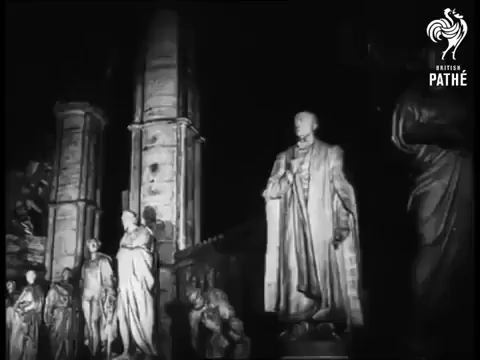 |
| Statues and busts in Westminster Abbey during the royal wedding festivities |
The marble figures of statesmen of the past postured on their pedestals; one of them gazed blankly over his counterparts of today in the choir, one looked sternly towards a line of cameras that were discreetly hidden from living eyes, and one held his arm outstretched in a perpetual attitude of benediction. And the organ embarked upon a fugue by Bach.
Now from behind the choir screen, which limited the vision of those in the north transept, there burst a brief blaze of pageantry as the members of the Honourable Corps of Gentlemen-at-Arms took up their positions, two to stand with their halberds on the sanctuary itself, the remainder in the lantern and the choir; in their red coats they were startling, and in their tall, white-plumed headdresses enormous. Now in the nave the Yeomen of the Guard were standing to attention, and by the Chapel of St. George there appeared members of that ancient body the Military Knights of Windsor. Thus, by this pomp, was symbolised the power of arms.
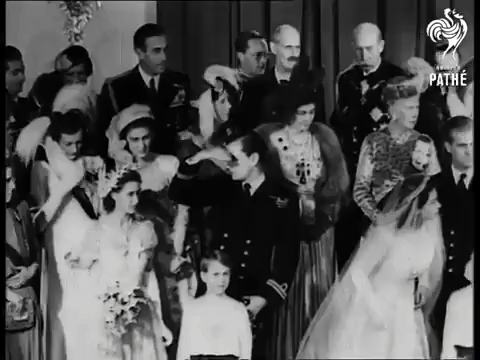 |
| Foreign royal guests gather with the Windsors for wedding photos |
There were four processions from the west door to the sanctuary. The first, which arrived before the altar shortly after eleven o’clock, was composed of ten princes and princesses, of Bourbon-Parma, Denmark, Luxembourg, and Yugoslavia [1], and twenty-three members of the royal family, including Lord and Lady Mountbatten [2], the last a graceful figure in a clinging dress of white silk. The members of the suites accompanying them were shown to their places in the south transept, and a little later Lord Harewood and his brother [3], two slight figures in khaki, hurried up and went to their places on the right of the sanctuary.
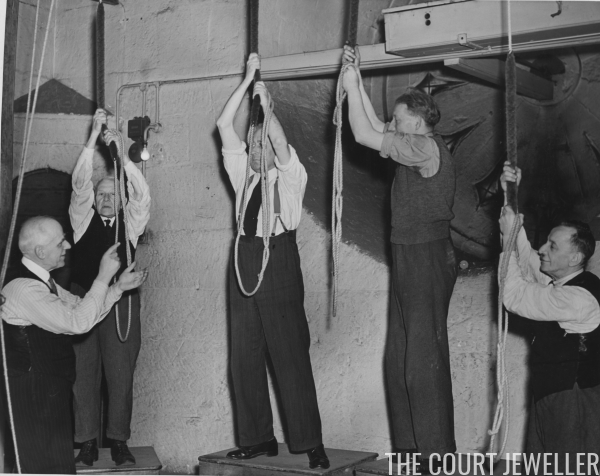 |
| Westminster Abbey’s bellringers practice the Royal Wedding peal a few weeks before the ceremony (Reg Speller/Fox Photos/Getty Images) |
There was a brief pause as the Dean and Chapter (in softly flowing capes that were new when Charles II was enthroned) returned to the west door, and over the muffled roaring of the crowd there broke the tumbling clangor of St. Margaret’s bells, ringing out a joyful peal. The sanctuary was well peopled, glowing already with jewel-like blues and reds like those of an old painting; but from a black headdress in the background diamonds flashed disturbingly.
The second procession, that of the Queen [4], was the longest. Slowly, as the “Water Music” of Handel rippled from the organ pipes, it moved along the nave and the choir, and when it came to rest there were six queens, five kings, and nine more princes and princesses in the sanctuary [5]. Here, in living concentration, were the constitutions, calm or troubled, of Britain, Denmark, Norway, Iraq, Romania, Belgium, the Netherlands, Luxembourg, Greece, and Sweden.
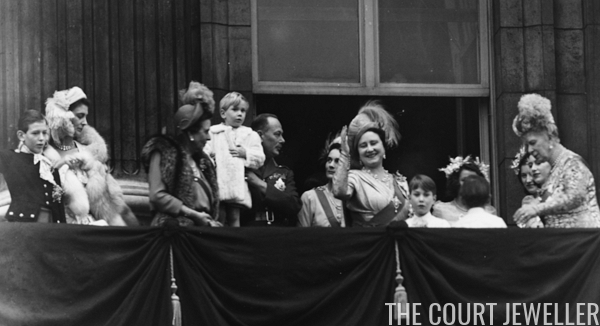 |
| Members of the royal family, including the Queen, Queen Mary, Princess Andrew, and the Duchesses of Kent and Gloucester on the balcony following the royal wedding (Hulton Archive/Getty Images) |
At last the scene was almost set and as full of colour as the most disgruntled enemy of mediocrity in occasions of state could have wished. The curious half-light of the Abbey, submarine almost in its quality, made recognition difficult, and, with one or two exceptions, it must have been knowledge of the robes and their colours alone which enabled the members of the congregation, stiff and still no longer but moving themselves forward and sideways to see the better, to distinguish individuals. But the Queen, in apricot and gold, was not to be mistaken; nor Queen Mary, vivid in aquamarine velvet, nor the Duchess of Kent, in pale silver-grey satin brocade.
The Archbishops of Canterbury and York, in priceless robes, the Bishops of London and Norwich, and, lastly, the more severely-clad Moderator of the General Assembly of the Church of Scotland, passed to the sedilia in solemn procession. From their hidden stance behind the reredos the trumpeters of the Royal Military School of Music sounded a shattering fanfare. Quietly, quickly, Prince Philip, Duke of Edinburgh [6], and his groomsman, Lord Milford Haven [7], went to their places by the sanctuary steps. The King [8] and the Princess [9] had arrived. The eighty voices of the choir were raised in the hymn “Praise, my soul, the King of Heaven…” and they were already moving along the nave, still hidden from all beyond the screen but the illustrious upon the sanctuary.
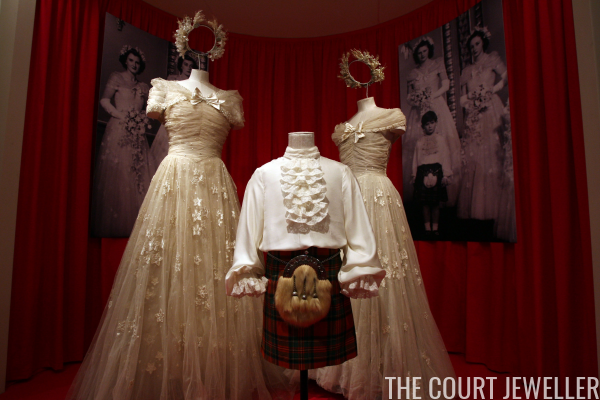 |
| Two bridesmaids dresses and a page boy’s outfit from the royal wedding (Peter Macdiarmid/Getty Images) |
And then, giving the extraordinary impression of unhurried speed, they appeared — the Princess gliding, not walking, beneath the frosty, sparkling mist of her veil, on the arm of her father. Behind were her pages, Prince Michael of Kent and Prince William of Gloucester [10], tiny, kilted in the royal tartan; and behind the pages eight slender figures in white, the bridesmaids, led by Princess Margaret and Princess Alexandra of Kent [11].
The King and the Princess were joined by the bridegroom, and all three ascended the sanctuary steps. Facing them were the mass of richly robed clergy, solemn beneath a forest of golden crosses. The scene now was fully set, and in that brief interval before the Dean intoned the words, “Dearly beloved,” there was a rustle of movement as members of the Royal Family and their guests stirred and smiled one to the other; a moment of relaxation.
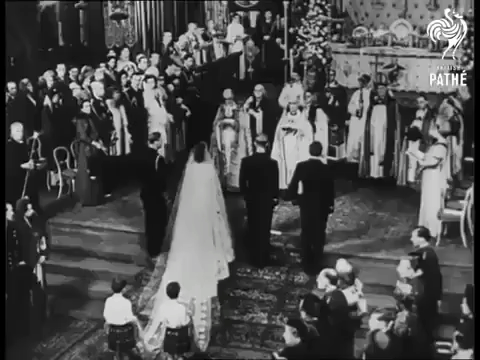 |
| The marriage service begins |
But the service began and continued unhurriedly; the Dean’s voice was replaced by that of the Archbishop of Canterbury; faintly came the bridegroom’s response to his question and still more faintly the bride’s, though that anxious hush which must always attend this moment in the ceremony, whether in the most obscure parish church or in the greatest abbey — and the man and woman on the sanctuary steps were man and wife.
And then they knelt, though all others in the Abbey remained standing, to hear (all worldly circumstance thus momentarily humbled) the prayer of the Archbishop, his pronouncement of the union to the congregation, and his first benediction. As the forty-seventh Psalm was sung they rose and moved forward, alone, to the altar and knelt again before it, this time to hear the Precentor intone the Lord’s Prayer, the Versicles, and the Collect.
By this time — for how could the atmosphere be mistaken? — the congregation, from any queen on the sanctuary to the typist at the northwest end of the nave, was one — united by the potent symbolism of the old ritual and conscious, too, of the underlying greatness of the union which had just been sanctified. But it was not, in the first place, a prince and a princess who were rising to their feet in the cramped but cosmically lonely space before the altar, but a man and a woman. This was expressed by the Archbishop of York in his address.
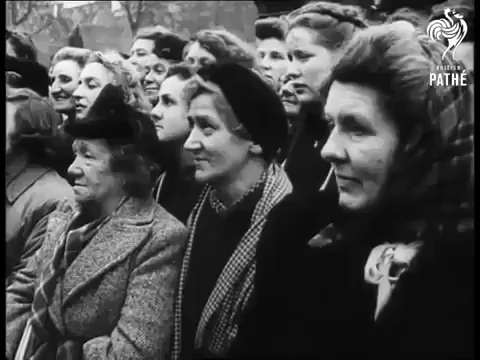 |
| Crowds gather to catch a glimpse of the bride and groom during the wedding festivities |
“Notwithstanding the splendour and national significance of this occasion,” he said (and a great vision of all the Western world and all its sorely tried central tradition rose to the mind at his words), “the service is in all essentials the same as for any cottager who might be married this afternoon in some small country church in a remote village. The same vows,” he continued in his high, clear voice, “are taken, the same prayers are offered, and the same blessings are given. Everywhere and always this service is built round the taking of vows and the receiving of a blessing.”
Thus the old Archbishop instructed them, this couple before him who listened with heads bowed. They had indeed already rehearsed their parts, but the form of them only; now they knew the spirit of the content and the realisation of the full significance of the sacrament — a significance shared by all in the Abbey — was yielded to them. They had taken their vows and received their first blessing. Now they heard the Archbishop of Canterbury pronounce the second and last benediction, followed by a swelling “Amen” from the choir.
But now there burst over all the heads once more the pomp of the world of palaces as the trumpeters sounded another fanfare, as the National Anthem was sung, as the whole vivid scene swam back into vision, increased in splendour by the words which had been spoken.
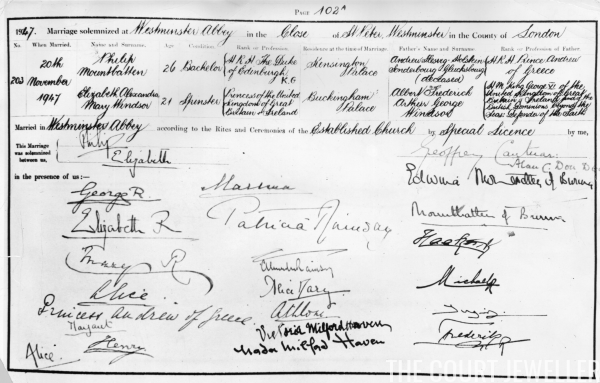 |
| The signed register from the wedding (Topical Press Agency/Getty Images) |
As the royal couple moved off through the doorway on the right of the altar to the chapel of King Edward the Confessor there to sign the register, they were accompanied by the King and Queen, Queen Mary, Princess Magaret, the Duke of Gloucester, and the Princess Andrew of Greece, the mother of the bridegroom. As the choir sang the anthem “Blessed be the God and Father” tension suddenly relaxed again and the sound of an animated whispering rose and mingled with the singing voices. What might or might not be said elsewhere was surely said here: how beautiful the bride, how splendid the bridegroom.
Yet another fanfare put an end to the whispering (and in the short lull which followed one noticed how very quiet it was outside as well as within the Abbey); the opening chords of Mendelssohn’s Wedding March pealed out and jostled beneath the lofty roof wiht the metal voices of the Abbey’s swinging bells.
Prince Philip and Princess Elizabeth appeared from the right-hand door of the chapel, smiling, and as they crossed the sanctuary to bow and curtsy to the King and Queen, Prince Philip looked anxiously behind him to make sure that the young Princes were bearing his wife’s train properly. Down the steps, smiling to right and left, they went, and behind the choir screen they were lost to sight.
Before them passed the King’s Scholars, the choir, the minor canons, the Canon’s verger, the canons, Mr. H.U. Willink and Lord Halifax — respectively High Bailiff and High Steward of Westminster — the Dean’s verger, and the Dean. Behind them went the pages and the bridesmaids, and last to be lost to sight was the groomsman. Thus the bridal procession disappeared, but soon the raised voice of the crowd told those inside that the bride and bridegroom had entered their carriage and were driving away.
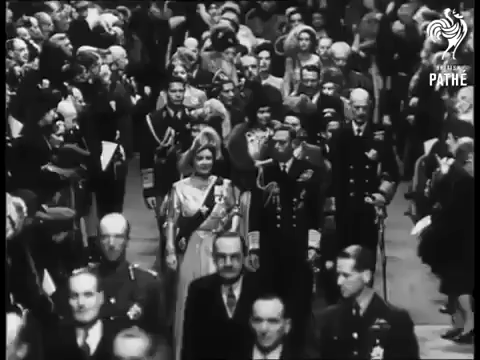 |
| The King and Queen lead the royal procession out of the Abbey |
The other processions followed, and soon those guests who could do so without appearing unseemly flocked out through the side doors to see the great and the famous pass between the people of London.
How slowly the Abbey emptied; but within half an hour the gold and cream chairs, the plate of gold, and the flowers were waiting once again, this time for the gaze of the public, which soon turned away from the processional route and formed an ever-growing queue outside the north door. As the last car drove up and away from the Abbey door the bells and the bands of London continued to give expression to the rejoicing. But the Abbey waited, empty, with that half-happy, half-melancholy air of a building in which an event of immense significance and potential joy has just taken place.
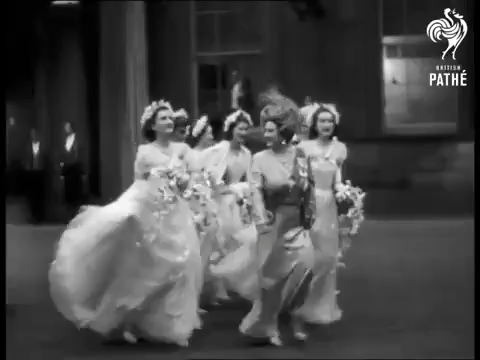 |
| The Queen and Princess Andrew walk with the bridesmaids after the wedding |
NOTES
1. The ten princes and princesses were Prince Rene of Bourbon-Parma with his wife, Princess Margrethe, and their children, Princess Anne and Prince Michel; Princess Margaretha of Denmark and her sons, Prince George and Prince Flemming; Princess Elisabeth of Luxembourg; and Princes Tomislav and Andrew of Yugoslavia.
2. Louis Mountbatten, 1st Earl Mountbatten of Burma (1900-1979) and his wife, Edwina (1901-1960), were the groom’s uncle and aunt.
3. George Lascelles, 7th Earl of Harewood was the bride’s first cousin; he had succeeded to the earldom after his father’s death in May 1947. His mother, the Princess Royal, declined to attend the wedding, so he was accompanied by his younger brother, the Hon. Gerald Lascelles.
4. Elizabeth Bowes-Lyon (1900-2002) was queen consort of the United Kingdom in 1947; she was the mother of the bride at this wedding.
5. This procession would have included Queen Elizabeth and Queen Mary of the United Kingdom; King Haakon VII of Norway; King Frederik IX and Queen Ingrid of Denmark; Queen Friederike of the Hellenes; King Faisal II of Iraq; King Michael of Romania; Helen, Queen Mother of Romania; King Peter II and Queen Alexandra of Yugoslavia; Queen Victoria Eugenie of Spain; Crown Prince Gustaf Adolf and Crown Princess Louise of Sweden; Hereditary Grand Duke Jean of Luxembourg; Princess Juliana and Prince Bernhard of the Netherlands; and Prince Charles of Belgium.
6. Prince Philip, Duke of Edinburgh (born 1921) was the groom at this wedding.
7. David Mountbatten, 3rd Marquess of Milford Haven (1919-1970) was a first cousin of the groom.
8. King George VI of the United Kingdom (1895-1952) had been on the throne for more than a decade at the time of this wedding; he was the father of the bride.
9. Princess Elizabeth of the United Kingdom (born 1926), later Queen Elizabeth II, was the bride at this wedding.
10. The page boys at the wedding, Prince William of Gloucester and Prince Michael of Kent, were both first cousins of the bride.
11. Princess Elizabeth had eight bridesmaids: Princess Margaret (her sister), Princess Alexandra of Kent (her first cousin), the Hon. Margaret Elphinstone (her first cousin), Diana Bowes-Lyon (her first cousin), Lady Mary Cambridge (her second cousin), the Hon. Pamela Mountbatten (Philip’s first cousin), Lady Caroline Montagu-Douglas-Scott (niece of the Duchess of Gloucester), and Lady Elizabeth Lambart.
Leave a Reply